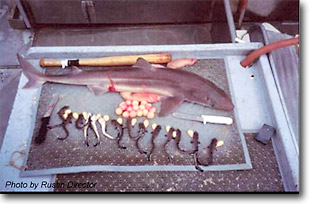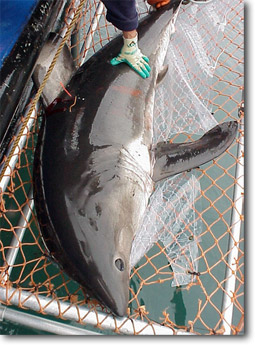Fieldwork
We present here a collection of images that represent the research we are doing. While none of these images tells a whole story, sometimes an image or two can vividly convey the essence of a project in ways words never can. We have tried to present images that are representative of the research and provide brief captions that put the image in context. More information can be found at the Research part of this web page where more scientific detail is presented, including the location of specific results.
It is important to note that while these images can get the heart beating faster and present our research in very dramatic ways, the mathematical modeling and analyses that we do in this laboratory are also dramatic and exciting. The thrill of deriving predictions and new understanding from abstract thought, combined with a synthesis of data collected in these field projects is less easy to describe but just as real.
Another aspect that is difficult to depict with photographs is the shark lab’s interest in the formulation of policy for the conservation and management of elasmobranchs at local national, and international levels. Biologists or mathematicians rarely see how their efforts contribute to the ultimate decision making about the protection of the animals and their environments. But it is the “end-game,” the culmination of a trail of effort and it’s exciting and satisfying to see it come together.
© 2005 University of Washington. All rights reserved.
Spiny Dogfish (Squalus acanthias) |
|
|
|
|
|
|
|
|
|
|
|
|
|
|
|
|
|
|
|
|
|
|
|
|
|
|
|
|
Learn about our cooperative research and the field work of NOAA’s Apex Predators Program |


 Dissected dogfish showing large litter of 14 embryos along with with 15 ova.
Dissected dogfish showing large litter of 14 embryos along with with 15 ova.  Spiny dogfish partially consumed by a partially consumed sixgill shark.
Spiny dogfish partially consumed by a partially consumed sixgill shark. This photo is taken from above as the sixgill shark and a dogfish are hooked on the long-line alongside the boat. The sixgill will soon be eased into the cradle being lowered into the water and then hoisted up and out of the water onto the deck. When on deck the scientists can work on the shark taking demographic measurements such as length and weight, sex, and so on. It is also marked with a uniquely identifying tag on its dorsal fin. While on board sea water is moved over its gills. Within about 4 minutes the hook is removed and it is moved back into the water in the cradle to swim away.
This photo is taken from above as the sixgill shark and a dogfish are hooked on the long-line alongside the boat. The sixgill will soon be eased into the cradle being lowered into the water and then hoisted up and out of the water onto the deck. When on deck the scientists can work on the shark taking demographic measurements such as length and weight, sex, and so on. It is also marked with a uniquely identifying tag on its dorsal fin. While on board sea water is moved over its gills. Within about 4 minutes the hook is removed and it is moved back into the water in the cradle to swim away. These hooks and baits (usually salted herring or squid) are placed on hooks of two different sizes for the purposes of catching different size animals. The baited hooks are on a long-line consisting of about 100 hooks and laid out over the sea bottom.
These hooks and baits (usually salted herring or squid) are placed on hooks of two different sizes for the purposes of catching different size animals. The baited hooks are on a long-line consisting of about 100 hooks and laid out over the sea bottom.  Sixgill shark in cradle. The shark had a yellow plastic band around its head—evidence of the urban environment in which these sharks live.
Sixgill shark in cradle. The shark had a yellow plastic band around its head—evidence of the urban environment in which these sharks live. Cradle is lowered into the waters to release sixgill shark.
Cradle is lowered into the waters to release sixgill shark. Salmon shark in cradle.
Salmon shark in cradle. A muscle tissue sample is taken from this salmon shark for genetic analysis.
A muscle tissue sample is taken from this salmon shark for genetic analysis. Shark cradle is lowered into the waters to release tagged salmon shark.
Shark cradle is lowered into the waters to release tagged salmon shark. A smart position only tag (SPOT) is deployed to investigate salmon shark migratory patterns.
A smart position only tag (SPOT) is deployed to investigate salmon shark migratory patterns. Blue shark in waters of the Azores archipelago.
Blue shark in waters of the Azores archipelago. Researcher filming video of blue shark in waters of the Azores archipelago.
Researcher filming video of blue shark in waters of the Azores archipelago.